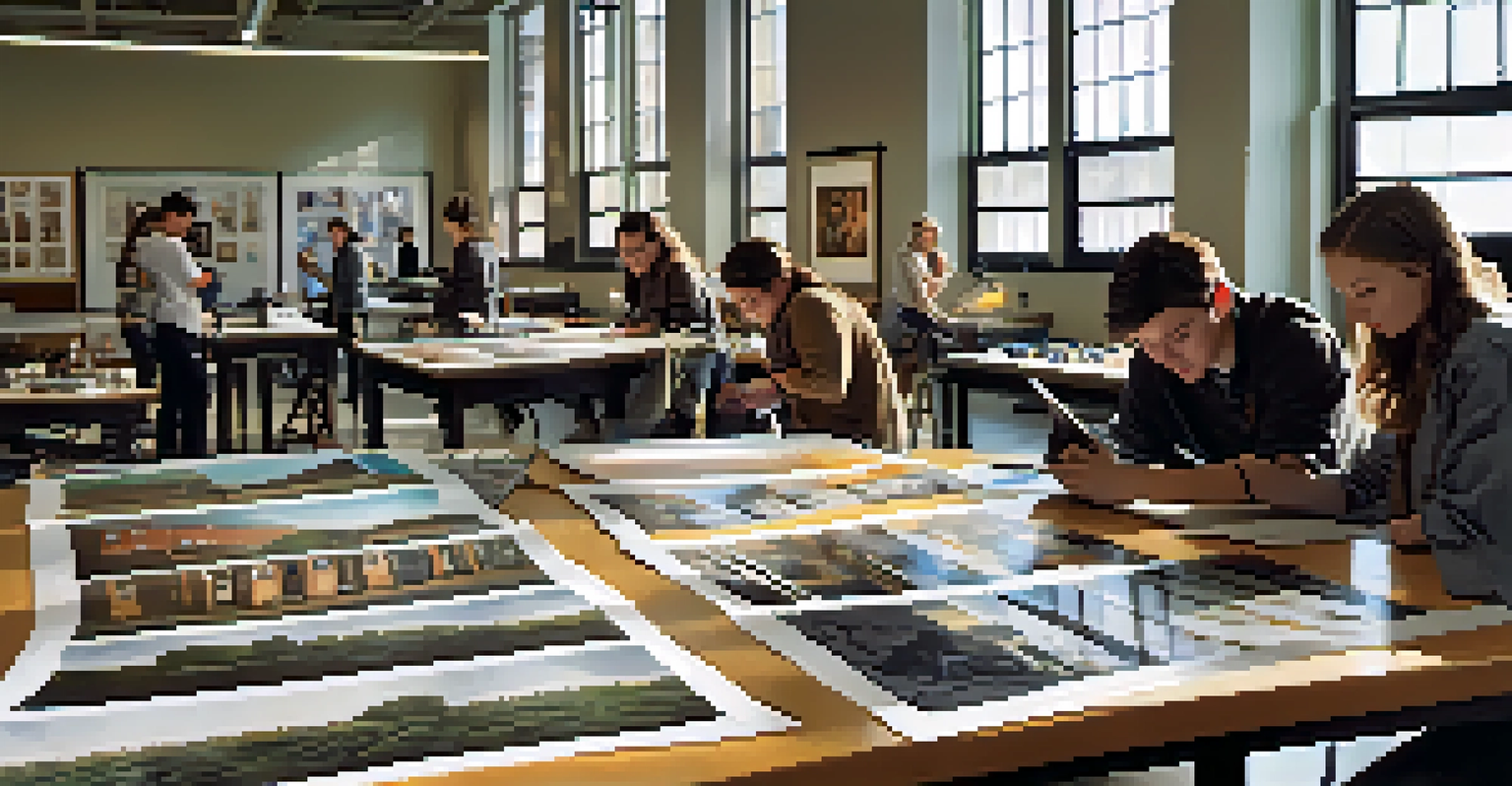Rochester's Role in the Global Photography Equipment Market

The Birthplace of Modern Photography Equipment
Rochester, New York, is often hailed as the birthplace of modern photography, with a rich history that dates back to the late 19th century. This city became a hub for photography innovation, largely due to the efforts of George Eastman, the founder of Eastman Kodak Company. His vision of making photography accessible to the masses led to the development of the first affordable cameras and film, changing the industry forever.
Photography is the story I fail to put into words.
The introduction of the Kodak camera in 1888 revolutionized how people captured moments. With its simple design and easy-to-use features, it allowed everyday individuals to engage in photography without needing extensive training. This democratization of photography not only propelled Kodak to prominence but also positioned Rochester as a key player in the global photography equipment market.
As technology progressed, Rochester continued to lead in photographic innovation, creating a legacy that influenced countless photographers and companies worldwide. The city's commitment to research and development in imaging technologies helped solidify its status as a cornerstone of the photography industry.
Kodak's Dominance and Its Ripple Effect
Kodak's rise to dominance in the photography market during the 20th century had significant implications for Rochester and the industry as a whole. At its peak, Kodak employed tens of thousands of people in the city, creating a strong economic base and attracting related businesses. The company's influence extended beyond Rochester, shaping global standards for photography equipment.

The introduction of color film and innovations like the Instamatic camera positioned Kodak as the household name in photography. This success inspired other companies to invest in research and development, leading to a competitive environment that fostered further innovation and diversified offerings in the market. As a result, Rochester became known not just for Kodak, but for a variety of companies and startups that emerged to meet the growing demand for photographic technology.
Rochester: Birthplace of Photography
Rochester, New York, emerged as a pivotal center for photography innovation in the late 19th century, largely due to George Eastman's efforts with Kodak.
However, Kodak's eventual struggles in the digital age serve as a reminder of the ever-evolving nature of technology. Despite facing challenges, the legacy of Kodak continues to influence new generations of photographers and innovators in the industry.
Emergence of New Players in Rochester
While Kodak was a giant in the photography field, Rochester also became a breeding ground for new companies and startups in the photography equipment sector. As the industry evolved, entrepreneurs began to explore niche markets, creating innovative products that catered to specialized photography needs. This shift not only diversified the local economy but also reinforced Rochester's status as a photography hub.
The camera is an instrument that teaches people how to see without a camera.
Companies like Vignette and Snapshots emerged, focusing on digital photography tools, editing software, and accessories. These businesses leveraged the city's rich history in imaging technology while incorporating modern trends and consumer demands. As they grew, they attracted talent and investment, further enriching Rochester's photographic landscape.
This entrepreneurial spirit has led to collaborations and partnerships within the community, fostering a vibrant ecosystem for photographers and creators. Through workshops, exhibitions, and local events, Rochester continues to inspire and support the next generation of photography enthusiasts.
Rochester's Impact on Educational Institutions
Rochester's influence in the photography equipment market extends beyond businesses to educational institutions that specialize in photography and imaging sciences. Renowned schools like the Rochester Institute of Technology (RIT) have produced a steady stream of talented photographers and engineers who contribute to the industry. RIT's programs focus on both traditional and modern photographic techniques, ensuring that students are well-prepared for the evolving landscape.
These educational programs often collaborate with local businesses, providing students with hands-on experience and opportunities to innovate. Internships and cooperative education programs allow students to apply theoretical knowledge in real-world settings, fostering a culture of creativity and problem-solving. This collaboration between academia and industry has helped Rochester maintain its relevance in the global photography equipment market.
Kodak's Impact on Local Economy
Kodak's dominance in the 20th century not only shaped global photography standards but also significantly boosted Rochester's economy and attracted related businesses.
As graduates from these programs enter the workforce, they bring fresh ideas and perspectives that challenge the status quo. This cycle of education and innovation keeps Rochester at the forefront of photographic technology, ensuring its continued contribution to the industry.
The Role of Local Events and Exhibitions
Rochester hosts several local events and exhibitions that celebrate photography and its equipment, drawing enthusiasts from all over the globe. These events provide a platform for photographers, equipment manufacturers, and educators to share their work and innovations. The annual Rochester International Jazz Festival, for example, often features photography exhibitions that showcase local talent and highlight the city’s artistic spirit.
Such events not only promote local artists but also encourage networking among industry professionals. They serve as a melting pot for ideas, fostering collaborations that can lead to groundbreaking projects and new products. By bringing together diverse perspectives, these gatherings help shape the future of photography equipment and its applications.
Moreover, they reinforce Rochester's identity as a vibrant community that values art and technology. The combination of local pride and global interest in photography makes these events a vital part of the city’s cultural fabric.
Challenges Facing Rochester's Photography Sector
Despite its rich history and continued innovation, Rochester's photography equipment sector faces several challenges in the modern market. The shift toward digital photography and smartphone cameras has significantly altered consumer behavior, resulting in a decline in traditional camera sales. As a result, many local businesses have had to pivot their strategies to remain relevant in an increasingly digital landscape.
Additionally, competition from global companies and emerging markets has intensified, requiring Rochester-based firms to innovate continuously. The need for adaptability is paramount, as businesses strive to meet the changing demands of consumers who prioritize convenience and high-quality images from portable devices. This pressure pushes local companies to focus on niche markets or develop cutting-edge technology to stay competitive.
Education Fuels Innovation in Photography
Local educational institutions, particularly the Rochester Institute of Technology, play a crucial role in nurturing talent and fostering innovation in the photography equipment sector.
However, challenges often lead to new opportunities. The ability of Rochester’s businesses to adapt and evolve in response to industry trends will ultimately determine their success in the global photography equipment market.
The Future of Rochester in the Photography Landscape
Looking ahead, Rochester's role in the global photography equipment market remains promising. With a strong foundation of innovation, education, and community support, the city is well-positioned to continue influencing the industry. As technology advances, Rochester can leverage its legacy and expertise to explore new frontiers in photography, such as virtual reality and artificial intelligence.
Collaboration among local businesses, educational institutions, and creative communities will be key. By working together, these stakeholders can foster an environment that encourages experimentation and embraces emerging technologies. This collaborative spirit will not only enhance Rochester’s reputation but also attract talent and investment from outside the region.

Ultimately, Rochester's future in the photography market will depend on its ability to adapt and innovate while staying true to its roots. By embracing change and nurturing creativity, Rochester can continue to be a significant player in the global photography equipment landscape.